August, 16 - 17 (4-5)
(From P.A.Zhilin "The Patriotic War Of 1812",
E.V.Tarle, Complete Works, Volume VII, "Napoleon's Invasion to Russia",Moscow 1959)
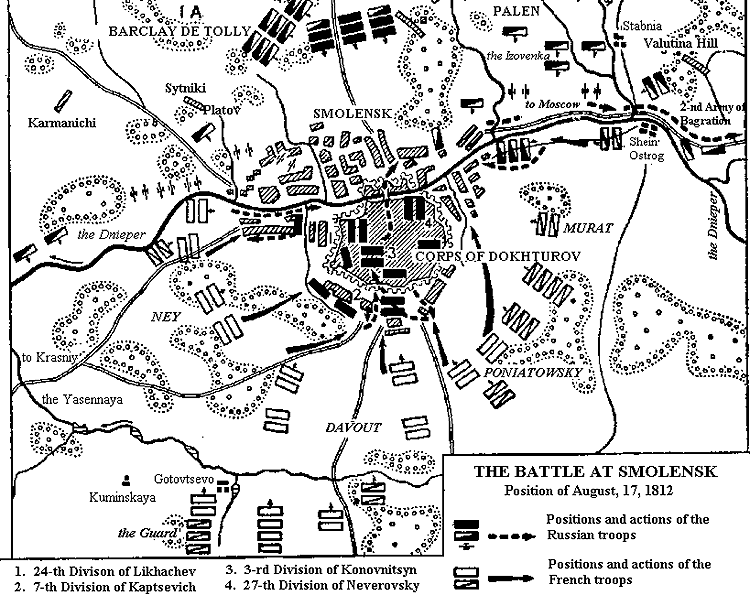
The Battle At Smolensk
Early in the evening of August,15th Raevsky and Neverovsky saw the endless line of campfires on the horizon. It was Napoleon with his main forces camped for the night, and he was heading straight to Smolensk. But nobody knew if he would stay there for the night or leave his camp and suddenly rush to the city.
What were they to do? Raevsky had only 13 thousand men, and the Napoleonic forces near Smolensk at that time totalled about 182 thousand. Raevsky had no orders nor the authority to defend Smolensk; the Russian Army had already begun its retreat from Smolensk to Moscow. Raevsky decided to defend the city.
Smolensk is located on the both sides of the Dnieper river and was protected by huge walls with 17 towers and many loop-holes for rifles. Behind the walls there were special mounts for the artillery. We could say the wall of stone and brick made a very strong fortification for those times.
The main part of the city was located on the eastern bank of the Dnieper.Also there were the suburbs of the city, where the troops of the 7th Russian Infantry Corps camped.
On the morning of August,16th the troops of Marshals Murat, Ney and Davout approached Smolensk from the South. Then Napoleon himself arrived. The French encircled the city and began a bombardment. The heavy artillery fire was terrible for the brave defenders. But the French could not crush their resistance. The Russians continued to repulse all the fierce attacks of the larger French forces.
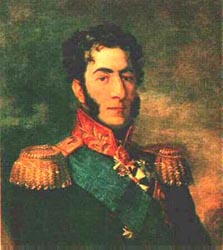 General Petr Bagration |
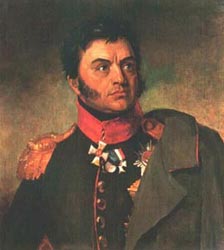
General Nickolay Raevsky |
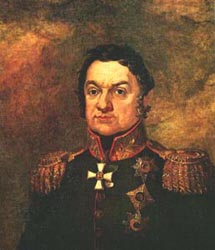
General Dmitry Dokhturov |
| The portraits by Dow | ||
Raevsky received a message that Prince Bargation was rushing to his aid after hearing of his decision to defend Smolensk. Bargation wrote: "My dear friend, I am not marching - I am running, I wish I had wings to come to you sooner!" In the evening of that same day Bagration was near Smolensk, but he too had not enough time. Barclay with his army was moving towards Smolensk too.
The battle raged all day, sometimes calm, sometimes violent. But all Napoleon's efforts to capture Smolensk on August,16th were repulsed.
Night came at last. Both sides were prepairing for mortal combat. During the night Barclay de Tolly ordered the Corps of General Dokhturov to take place of the Raevsky's units which had suffered heavy losses.
At 4 a.m., August,17th the battle near the walls of Smolensk began again and continuous artillery fire lasted 13 hours until 5 p.m. By then, most of the suburbs of Smolensk were enveloped in flames and parts of the city were burning too. The attacks followed one another after each terrible cannonade, but every time the Russians beat them back.
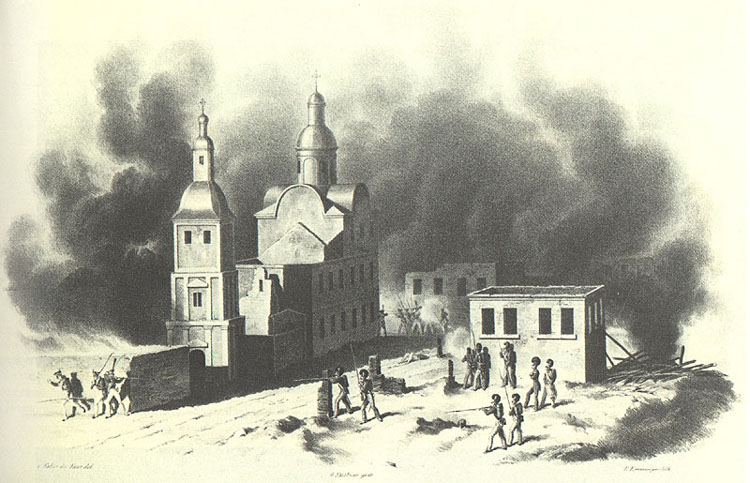
Near the walls of Smolensk. August,18 at 5 p.m.
The drawing by Faber du Faur
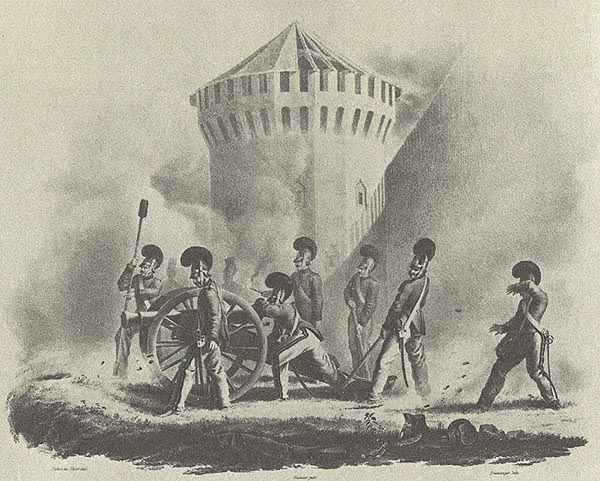
Near the walls of Smolensk. August,18
The drawing by Faber du Faur
The Russians had to leave Smolensk, to delay would have meant death for the army. Barclay knew what the reaction of people would be to his decision, but he also knew there was no other way to save the army and that his own fate had been predetermined.
On August,18 at 2 p.m. after blowing up the powder stores the cossacks rode along the streets of Smolensk, notifying everyone about the retreat of the Russian army and inviting all who wanted to leave the city to go immediately as the bridge across the Dnieper was not yet on fire. Most of the inhabitants who rushed after the retreating Russian troops were old men, women, and children in carts and on foot, but some stayed in the city.
Two hours before daybreak, the Corps of General Dohkturov left the city and destroyed the bridge across the Dieper. The last Russian detachment to leave Smolensk was the Konovnitsyn's division.
At 4 a.m. the troops of Marshal Davout entered Smolensk, and besides setting numerous fires, began the sacking the city. The German and Polish soldiers of Napoleon's army plundered most of all, but witnesses said the French, the Dutch and the Italians robbed much less.
About two thousand inhabitants that left their burning houses took cover in the catherdral. Many people lived there for more than two weeks.
The circumstances of the fall of Smolensk made a great impression on the French. They had captured Smolensk, but in only two days of combat about 20 thousand of their soldiers were killed and wounded (the losses of the Russian troops were about half that).
Napoleon, in Smolensk, was in a very bad mood. He realized though the Russian army retreated, it was not crushed, and the main forces were saved. The Russian army had escaped the French again. Besides, the new Russian troops of General Miloradovich were coming and the first regiments of the Russian militia appeared. The Russian partisans ambushed the roads and made raids on the French garrisons and transports. The French could not send their foragers without armed guard.
The so-called Petersburg suburb had been burning for a long time. The main Russian troops had already left Smolensk and the French were entering, but the Russian rear-guard under the command of General Konovnitsyn and Colonel Toll was fighting desperately and continuing to delay them.
The Russian riflemen were dispersed among the gardens and acted alone, firing at the coming dense French line and the crews of the French artillery. The Russian knew, of course, that they would be killed in a short time, but they didn't want to leave:
Napoleon knew The Russian troops had fought at Smolensk with great courage and fortitude, and many French witnesses wrote in their reports of many impressive episodes.
One Russian chasseur was especially distinguished by his bravery and fortitude, he was just in front of us, on the bank under the willows. We could not stop his firing by our rifle fire alone, And even after one of our cannons had been ordered to fire only at him and shredded all the trees in which he hid himself, he continued firing, only stopping at night. The next day, after crossing the river, we came to his postion and saw our enemy: it was a non-commissioned officer of the Russian chasseurs. He lay dead among the pieces of shattered wood - killed by a cannon-ball, he had fallen bravely, not leaving his post.Thus wrote French Colonel of Artillery, Faber du Four (1) .

This chasseur your can see on the drawing made by Faber du Four
- Kolubakin B. "The Year of 1812", page 106
